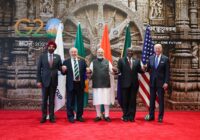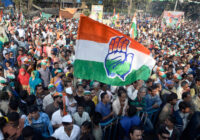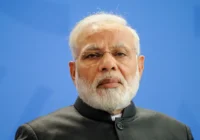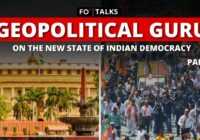In the recently concluded state-level elections in three northern “Hindi heartland” states, the Indian National Congress (INC), the primary national opposition party, fared poorly. The Bharatiya Janata Party (BJP), the national ruling party headed by Prime Minister Narendra Modi, won a resounding victory. However, the INC beat the BJP in the only southern state that went to polls, Telangana. This has rekindled the longstanding North versus South debate. Many commentators ascribe the INC victory to South India’s higher literacy, better social infrastructure and lower communal tensions. A member of parliament (MP) from South India has referred to North Indian provinces as gau mutra (cow urine) states, adding fuel to the fire of this regional divide.
Other commentators reject the terms of this debate. They argue that it oversimplifies a complex issue and stokes imaginary regional differences. The issue at hand is the delicate balance between states. India’s significant diversity traces its roots to prehistoric times. Genetic research shows that modern Indians came from at least four waves of migration into the subcontinent. This has resulted in persisting genetic differences between people from different parts or communities of the country. For example, some researchers have found that people from lower castes have lower Central Asian and European genetic ancestry than those from higher castes. Similarly, the Dravidian-speaking populations of South India show noticeable genetic differences from the Indo-European-speaking populations of North India. Only in recent times has there been some exchange of vocabulary and grammar.
As deep-rooted as they may be, these differences are only ancillary to the project of the modern Indian republic. Forged in the collective resistance to British colonialism and the millennia of deep cultural exchange that preceded it, the country’s unity is enshrined in its constitution’s first words, “We, the people of India.”
Today, any recent Hindi-language superhit movie has drawn inspiration from the South’s regional cinema, and vice-versa. Athletes from various parts of the country powered India’s history-making medal tally in the recent Asian games. The national government seeks to further solidify this convergence through policy initiatives like a unified tax system and large, centralized welfare schemes.
Regional differences are growing
These successes of national integration should not lull even the staunchest “unionists” into a false sense of complacency. Underlying the modern Indian republic is a fundamental and growing chasm between its different regions. The differences between Indian states on many socio-economic parameters are more significant than between countries in other parts of the world. The South Indian state Kerala’s infant mortality rate is within striking distance of that of the US. In contrast, the North Indian state of Madhya Pradesh’s rate is closer to the rates of war-torn and violence-ridden Afghanistan and Niger.
Economic disparities between regions are not unique to India. In the UK, if one excludes London, the country has a lower per-capita income than Mississippi, the poorest state in the US. However, India is unique in one aspect. In other countries like the UK and the US, the economically more robust regions are also more populous. These regions subsidize the poorer, less populous parts of the country. In India, the poorer North is far more populous than the richer South, and this asymmetry is growing. In a democratic system based on the “one person, one vote” principle, the richer southern states are thus losing political power.
South Indian state Karnataka contributes 2.12 rupees to central taxes for each rupee it receives from New Delhi. In contrast, the North Indian state of Uttar Pradesh — India’s most populous province — contributes only 0.56 rupees to the national treasury for each rupee it receives. Clearly, South Indian states subsidize their North Indian counterparts.
In 2026, the long-pending delimitation of parliamentary constituencies is due. When that happens, the South Indian state Karnataka will likely lose 7% of its seats in the Lok Sabha, the lower house of India’s parliament, whereas Uttar Pradesh will gain 14%. Other South Indian states like Tamil Nadu, Kerala, Telangana and Andhra Pradesh will lose out in the 2026 delimitation as well. Even as South India subsidizes North India, this more prosperous part of the country is losing political power.
Political preferences are exacerbating regional differences
The growing dichotomy between economic and political power poses a significant threat to the stability of the Indian Union. After all, citizens from South India have already begun asking whether their diminishing clout at the national level is fair. The reason South India’s population growth has slowed down is that southern states have implemented better female literacy and family-planning initiatives since independence in 1947. These states feel they are being penalized instead of rewarded for succeeding in their developmental goals.
Despite its recent growth in Karnataka, only 9% of members of the legislative assembly (MLAs) in South Indian states belong to the BJP. In contrast, the figure for the INC is 27% while 64% of the MLAs belong to regional parties.
Not only South India, but also some eastern states, like Odisha and West Bengal, and even northern states like Himachal Pradesh, Punjab, and Uttarakhand will lose national political power in the 2026 delimitation. The BJP represents only 15% of MLAs in the “losing” states. This new delimitation will benefit the BJP while hurting the INC and India’s regional parties.
The BJP dominates the “gaining” states, which include Uttar Pradesh, Bihar, Rajasthan, Madhya Pradesh, Jharkhand, Haryana, Gujarat, Delhi and Chhattisgarh. In these states, 56% of the MLAs belong to the BJP. Except for Delhi, India’s saffron party rules all of these states.

This growing crisis of Southern representation is already clear in Parliament. Fewer than 10% of BJP’s MPs in the Lok Sabha are from the five southern states. Note that South Indian MPs comprise nearly 25% of the Lok Sabha. This number tells us that South India is suffering a double whammy. Not only are southern states losing their parliamentary clout in the coming delimitation, but they are also not adequately represented in the BJP government. The BJP’s support comes mainly from North India. Therefore, its incentive is to bestow financial largesse to the Hindi heartland states, which have fueled the party’s rise to power and will become even more important after the 2026 delimitation.
Some solutions to the North-South problem
It is entirely plausible that this looming North–South crisis may not come to pass. States in North India and South India might converge faster economically and demographically than expected. This would reduce the divergence between their political preferences. Or the national government of today and tomorrow might not covertly or overtly favor the states from which it draws power. Yet India can ill afford to leave the future stability of its political structure to these uncertain factors. Instead, structural solutions that prevent the build-up of political friction within the country are the need of the hour.
One solution is diminishing the overwhelming dominance of the national government by changing its country’s fiscal structure. Today, about two-thirds of the tax revenue goes to the national government in New Delhi even though it accounts for approximately one-third of the national expense. Instead, states must retain more of the tax revenue they generate. Then, they will feel less of a sense of injustice from the central government allocating tax revenues to different states
These reforms will bring financial decision-making to a lower level of government, where each voter has a more significant say than when voting for a national government far away in the national capital. Such financial devolution is likely to improve social outcomes because state governments are structurally more responsive to voter preferences.
Our founders were not complacent about national integration at independence. Partition accompanied independence in 1947. India’s diversity raised fears of disintegration and the founders opted for a strong national government. Initially, this government chose socialism, slowing down the economy because of the license-permit-quota raj. Liberalization in 1991 unleashed economic growth, and now India needs a competitive federalism that can unleash the next wave of growth. Greater fiscal power for state governments will defuse the tensions between the North and South over the 2026 delimitation, boost growth, and increase national integration.
[Liam Roman edited this piece.]
The views expressed in this article are the author’s own and do not necessarily reflect Fair Observer’s editorial policy.
Support Fair Observer
We rely on your support for our independence, diversity and quality.
For more than 10 years, Fair Observer has been free, fair and independent. No billionaire owns us, no advertisers control us. We are a reader-supported nonprofit. Unlike many other publications, we keep our content free for readers regardless of where they live or whether they can afford to pay. We have no paywalls and no ads.
In the post-truth era of fake news, echo chambers and filter bubbles, we publish a plurality of perspectives from around the world. Anyone can publish with us, but everyone goes through a rigorous editorial process. So, you get fact-checked, well-reasoned content instead of noise.
We publish 2,500+ voices from 90+ countries. We also conduct education and training programs
on subjects ranging from digital media and journalism to writing and critical thinking. This
doesn’t come cheap. Servers, editors, trainers and web developers cost
money.
Please consider supporting us on a regular basis as a recurring donor or a
sustaining member.
Will you support FO’s journalism?
We rely on your support for our independence, diversity and quality.










Comment